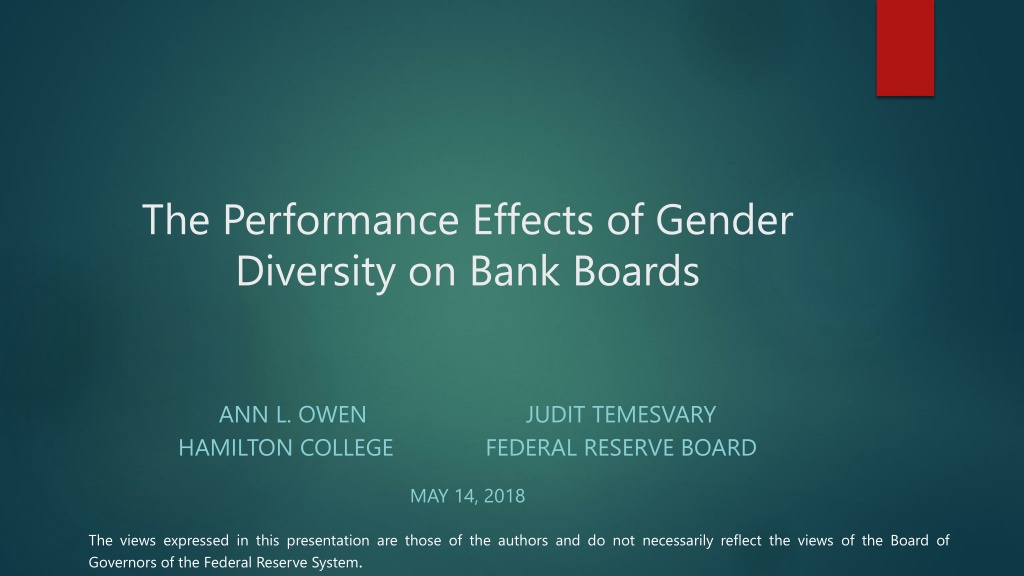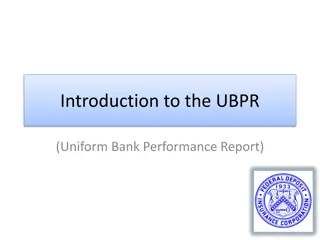Gender Diversity Impact on Bank Performance
This presentation explores the relationship between gender diversity on bank boards and bank performance, analyzing the effects on efficiency, profitability, and overall performance. It examines the mixed results from studies and discusses how well-managed banks may benefit from greater gender diversity, with a threshold effect observed around 13 to 17 percent female representation. The implications highlight the importance of context in understanding the performance implications of gender diversity in banking leadership.
Download Presentation

Please find below an Image/Link to download the presentation.
The content on the website is provided AS IS for your information and personal use only. It may not be sold, licensed, or shared on other websites without obtaining consent from the author.If you encounter any issues during the download, it is possible that the publisher has removed the file from their server.
You are allowed to download the files provided on this website for personal or commercial use, subject to the condition that they are used lawfully. All files are the property of their respective owners.
The content on the website is provided AS IS for your information and personal use only. It may not be sold, licensed, or shared on other websites without obtaining consent from the author.
E N D
Presentation Transcript
The Performance Effects of Gender Diversity on Bank Boards ANN L. OWEN HAMILTON COLLEGE JUDIT TEMESVARY FEDERAL RESERVE BOARD MAY 14, 2018 The views expressed in this presentation are those of the authors and do not necessarily reflect the views of the Board of Governors of the Federal Reserve System.
Research question Our research question: What is the relationship between the gender diversity of banks boards and bank performance? Specifically: How does gender diversity of banks boards relate to banks efficiency and profitability? How do these relationships change as gender diversity of boards increases? Under what circumstances does gender diversity affect performance?
Motivation Underrepresentation of women in leadership positions Studies on performance effects of female participation on boards (including in the banking industry) show mixed results Positive effects on performance: Gul et al., 2011; Campbell and Minguez- Vera, 2008; Noland et al., 2016; Kang et al., 2009; Schmid and Urban, 2016 Negative effects: Ahern and Dittmar, 2012; Adams and Ferreira, 2009 Little or no impact: Farrell and Hersch, 2004; Ferrari et al., 2016
Preview of results Impact of gender diversity on performance depends on bank and board traits: Better managed banks are more likely to reap positive benefits from greater gender diversity. Higher capital ratios proxy for quality of management (Mehran and Thakor, 2011; Bhat and Desai, 2016) There is a threshold effect: the share of women on bank boards must reach around 13 to 17 percent before performance benefits accrue Some suggestive evidence that more gender diverse boards provide both better monitoring and better strategic advice to banks
Implications and contributions Provides a reason for inconclusive and conflicting results from existing literature Banks continued (voluntary) expansion of board gender diversity is likely to bring overall performance benefits, provided that the banks are well managed Context matters
Why and how does gender diversity matter? Characteristics of the female board members Contribute specific functional (task-related) expertise (Kim and Starks, 2016) Women who get elected to boards are chosen due to exceptional performance (Schmid And Urban, 2016) Better monitors (Adams and Ferreira, 2009) Gender diversity is a board characteristic Increases the diversity of opinions and mitigates groupthink May lead to conflict within the board (Berger et al, 2014) An indicator of more meritocratic selection of board members (Besley, Folke, Persson, and Rickne, 2017)
Data: Bank performance and board diversity We use a newly compiled dataset on the gender composition and demographic characteristics of 87 U.S. bank holding companies over 1999-2015 Combine board data from Boardex with bank performance measures derived from from Compustat and Bankscope Bank performance measures: Efficiency: Revenue to Expense Ratio Profitability: Return on Assets Risk-adjusted profitability: Sharpe Ratio Market-based assessment: annual stock price growth Board diversity measures: lower values = less gender diversity Female Share of Board sample average 12.5%, but of boards < 17% Blau Index (Blau, 1977) ? ??2 100 ? = 1 ?=1
Data: Board demographics and experience Average Age and Wealth of Board Members Average Bank Board Tenure: Number of years on bank boards: around 6 years on average Average Board Experience: Number of bank boards which board member has served on: 5 boards on average Overall Board Tenure: Number of years on boards of publicly listed (non-bank) companies around 9 years on average Spreads of all three measures: Measures dispersion by accounting for mean median difference
Data: Controls for bank characteristics Loan to deposit Ratio: Measure of liquidity conditions Acquisition dummy: Captures M&A activity Risk-weighted capital ratio: Quality of management Board size: Overall number of bank board members: ranges from 6 to 32, mean of 13
Estimation methodology Main specification: ? ?)2+ ?? 1 ? ? ?)2] ???= ?0+ ?1?? 1 + ?2(?? 1 [?3?? 1 + ?4(?? 1 ? ? + ?7??+ ?8??+ ??? +?5?? 1 + ?6?? 1 ?: Blau index : Board characteristics ?? & ??: Bank & year FE s ? ?? 1 ?? 1 ?: Bank balance sheet traits ?? 1 IV specification (first-stage): ? ? ? ???= ?0+ ?1???+ ?2?1999 ? ?? +?3?? 1 +?4?? 1 + ?5??+ ?6??+ ?
Main Results Summary Relationship between gender diversity and bank performance depends on the existing level of diversity, and varies with the risk-weighted capital ratio Generally, performance declines with additional diversity at low levels of existing diversity, but improves at higher levels of diversity Revenue to expense ratio increases with gender diversity once the share of women on boards reaches around 17 percent Return on Assets increases with gender diversity at well-capitalized banks, once the share of women on boards reaches around 13 percent Sharpe Ratio increases with gender diversity at well-capitalized banks, once the share of women on boards reaches around 20 percent Marginal effects for the impact of stock price growth are only significant at the extremes
Results: Gender Diversity and Bank Performance Revenue/Expense ROA Sharpe Ratio Stock Price Growth VARIABLES [1] [2] [3] [4] [5] [6] [7] [8] Gender Diversity Blau Index {t-1} 3.790* [2.101] 3.715* [2.216] 0.289** [0.132] 0.276** [0.136] 0.779** [0.378] 0.673 [0.415] 3.753* [2.165] 3.720* [2.173] Blau Index {t-1} * Risk-Weighted Capital Ratio {t-1} -0.327** [0.145] -0.0752* [0.0450] -0.325** [0.153] -0.0744 [0.0469] -0.0215** [0.009] -0.00619* [0.003] -0.0207** [0.009] -0.00598* [0.003] -0.0710*** [0.0264] -0.0142* [0.00741] -0.0633** [0.0291] -0.0123 [0.00778] -0.266* [0.162] -0.0836* [0.0443] -0.269* [0.162] -0.0835* [0.0444] Blau Index {t-1} * Blau Index {t-1} Blau Index {t-1} * Blau Index {t-1} * Risk-Weighted Capital Ratio {t-1} 0.00639** [0.00312] Yes Yes 730 0.26 0.24 0.00635* [0.00326] Yes Yes 729 0.36 0.24 0.000467** [0.0002] Yes Yes 632 0.82 0.11 0.000453** [0.0002] Yes Yes 631 0.75 0.11 0.00124** [0.000500] Yes Yes 328 0.71 0.01 0.00112** [0.000527] Yes Yes 327 0.73 0.01 0.00614* [0.00333] Yes Yes 687 0.84 0.46 0.00620* [0.00334] Yes Yes 687 0.80 0.46 Bank Fixed Effects Year Fixed Effects Observations P-Value of Sargan Test Statistic R-squared
Other board characteristics Banks with boards whose members have served on many boards fare better Supports the idea that diversity of experience is positive for bank performance
Gender diversity and regulatory enforcement actions Greater gender diversity is associated with fewer Federal Reserve enforcement actions The lower number of enforcement actions is a result of a lower probability of any enforcement action The type of enforcement actions which decline are related to financial health No evidence that enforcement actions related to illegal activity are reduced
Gender Diversity and regulatory enforcement actions [1] [3] [5] [7] Number of Fed Enforcement Actions Probability of "Financial Health" Enforcement Actions Probability of "Illegal Activity" Enforcement Actions Probability of Fed Enforcement Actions Measure of Bank Performance VARIABLES Gender Diversity Blau Index {t-1} 0.00553 [0.0171] 0.0591 [0.0372] 0.0731* [0.0438] -0.00439 [0.0210] Blau Index {t-1} * Blau Index {t-1} -0.000680* [0.000364] -0.00225** [0.000881] -0.00225* [0.00125] 0.000228 [0.000547] Bank Characteristics Acquisition Dummy {t-1} 0.075 [0.0492] 0.0419 [0.253] 0.00432 [0.0134] 0.042 [0.241] -1.063 [1.196] -0.148*** [0.0466] 0.300 [0.298] -5.220*** [1.517] -0.0866 [0.0887] 0.001 [0.172] 0.192 [0.649] -0.0402 [0.0315] Loan to Deposit Ratio {t-1} Board Size {t-1}
Board gender diversity during the financial crisis Increased gender diversity is especially impactful during the crisis This result, combined with results on regulatory actions, suggests that increased gender diversity improves both decision-making and board oversight.
During the Crisis [1] [2] [3] [4] Revenue to Expense Ratio Return on Assets Annual Stock Price Growth Measure of Bank Performance Sharpe Ratio Marginal effect of a one standard deviation increase in the Blau index, for well-capitalized banks (at the 90th percentile) with low Blau index (at the 10th percentile) in non-crisis years: -22.826 [6.731]*** -1.013 [0.453]** -6.250 [1.701]*** -7.732 [9,286] Marginal effect of a one standard deviation increase in the Blau index, for well-capitalized banks (at the 90th percentile) with high Blau index (at the 90th percentile) in non-crisis years: 6.810 [5.642] 0.407 [0.225]* 0.830 [0.714] 7.963 [6.188] Marginal effect of a one standard deviation increase in the Blau index, for well-capitalized banks (at the 90th percentile) with low Blau index (at the 10th percentile) during the crisis: -40.705 [12.399]*** -2.118 [0.946]** -11.155 [3.267]*** -17.106 [15.413] Marginal effect of a one standard deviation increase in the Blau index, for well-capitalized banks (at the 90th percentile) with high Blau index (at the 90th percentile) during the crisis: 90.451 [51.467]* 3.747 [3.101] 19.216 [9.451]** 85.722 [57.010]
Conclusion The impact of gender diversity is context dependent This work emphasizes the importance of studying the impact of gender diversity in a nuanced way More research needs to done on why this effect exists An indicator of more meritocratic selection process for board members? An indicator of better monitoring? An indicator of better strategic advice? Banks continued voluntary expansion of board gender diversity is likely to bring overall performance benefits, provided that the banks are well managed (capitalized)
Additional Materials: Endogeneity Endogeneity of board gender diversity is an important concern Why is it important: Board diversity might respond to existing stress (Fich, 2005; Mateos de Cabo et al., 2012) Board experience likely correlated with gender diversity (Kim and Starks, 2016) Women may self-select into better firms (Farrell and Hersch, 2004) What we do about it: 1. IV Strategy Share of independent directors: Correlated with gender diversity but not bank performance (Pi and Timme, 1993; de Andres and Vallelado, 2008; Muller-Kahle and Lewellyn, 2011; Aebi et al, 2012; Adams & Mehran, 2012) Initial Blau index (1999) times year fixed effects (Ahern and Ditmar, 2012) 2. Use Lagged Values (Anderson et al, 2006)
Additional materials: First stage results for IV regressions Table 2A: First-stage IV Results for Revenue to Expense Ratio Regressions The Role Board Experience and Balance Sheet Traits in Determining US Banks' Blau Index 1999 - 2015 VARIABLES [1] [2] [3] [4] [5] [6] [7] [8] Board Characteristics Average Wealth of Board Members {t-1} 0.367 [0.56] -47.489 [12.231]*** 0.473 [0.566] -40.393 [13.414]*** -6.057 [4.584] 0.779 [2.404] 0.4 0.324 [0.561] -62.75 [14.202]*** [0.563] -47.129 [12.284]*** Average Age of Board Members {t-1} Average Bank Board Tenure {t-1} -11.204 [4.179]*** 0.364 [2.417] Spread of Bank Board Tenure {t-1} Average Board Experience {t-1} -2.005 [3.655] 1.088 [1.535] -1.016 [3.609] 1.066 [1.519] Spread of Board Experience {t-1} Average Overall Board Tenure {t-1} -0.018 [2.018] 0.891 [0.671] -0.547 [1.545] Yes Yes Yes 634 0.42 5.051 [2.3]** 0.965 [0.657] 0.364 [1.51] Yes Yes Yes 633 0.45 Spread of Overall Board Tenure {t-1} Constant 0.091 [1.536] Yes Yes Yes 635 0.41 -0.234 [1.524] Yes Yes Yes 634 0.44 0.217 [1.573] Yes Yes Yes 635 0.43 0.126 [1.569] Yes Yes Yes 634 0.44 0.112 [1.539] Yes Yes Yes 635 0.42 -0.221 [1.528] Yes Yes Yes 634 0.44 Bank Fixed Effects Year Fixed Effects Year Fixed Effects * Blau Index {1999} Observations R-squared































